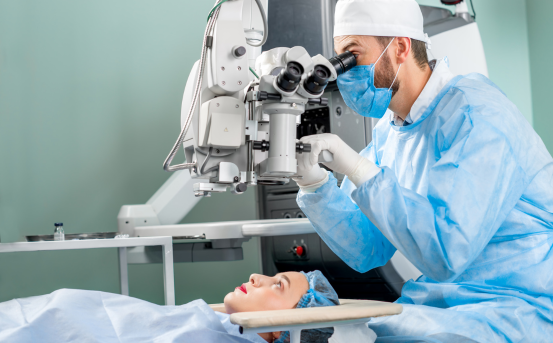Scleral buckling surgery is a well-established treatment used to repair retinal detachment, a serious condition that can lead to permanent vision loss if left untreated. Early diagnosis is critical to prevent complications and preserve vision.
However, the success of any retinal detachment treatment hinges on early and accurate diagnosis. Identifying the type, location, and severity of the detachment is crucial in determining whether scleral buckling is the most suitable intervention. In some cases, other surgical techniques like vitrectomy or pneumatic retinopexy may be preferred. But for many patients especially younger individuals or those with specific tear patterns scleral buckling remains a preferred option due to its durability and proven results.
What Is Scleral Buckling Surgery?
Before diving into diagnosis, it’s important to understand what scleral buckling surgery is. This surgical procedure involves placing a silicone band (called a buckle) around the white part of the eye (sclera) to push it inward. This relieves the tension pulling the retina out of place, allowing it to reattach and heal.
Scleral buckling is primarily used to treat rhegmatogenous retinal detachment, which occurs when a tear or hole in the retina allows fluid to seep underneath, causing the retina to peel away from the underlying tissue.
Why Early Diagnosis Matters
Retinal detachment is considered an ophthalmic emergency. If the retina remains detached for too long, the photoreceptor cells can suffer permanent damage, leading to irreversible vision loss. Early diagnosis and treatment improve the chances of successful reattachment and vision restoration.
That’s why prompt and accurate diagnosis for scleral buckling surgery is crucial. The sooner the condition is identified, the more treatment options are available including scleral buckling, pneumatic retinopexy, and vitrectomy.
Common Symptoms That Prompt Diagnosis
Patients with retinal detachment often report the following symptoms, which may lead to further investigation :-
-
Sudden appearance of floaters (dark spots or lines in vision)
-
Flashes of light in one or both eyes
-
A shadow or curtain-like area of vision loss
-
Blurred or distorted vision
-
Reduced peripheral (side) vision
When a patient presents with these symptoms, an eye specialist will initiate a series of diagnostic tests to confirm the cause and determine the best course of action, such as scleral buckling surgery.
Who Needs Scleral Buckling Surgery?
Not every case of retinal detachment requires scleral buckling. The surgery is most effective in certain types of detachment, especially in :-
-
Young patients with uncomplicated retinal tears
-
Patients with a single retinal break or localized detachment
-
People with no history of vitrectomy or complex eye surgery
-
Cases where the vitreous gel has not fully liquified
Patients with more complex detachments or those caused by traction or fluid buildup may require alternative procedures like pars plana vitrectomy.
Diagnosis for Scleral Buckling Surgery
The diagnosis for scleral buckling surgery involves several key steps and tools. Let’s explore how ophthalmologists confirm a retinal detachment and decide whether scleral buckling is the appropriate treatment.
Comprehensive Eye Exam
The first step is a thorough ophthalmic examination, where the eye doctor evaluates the patient’s visual acuity and inspects the external and internal structures of the eye. Key tools include :-
-
Visual acuity test (to assess central vision)
-
Pupil dilation (to better view the retina)
-
Slit-lamp biomicroscopic (for anterior eye inspection)
-
Tonometry (to measure intraocular pressure)
Dilated Fundus Examination
Using a special instrument called an ophthalmoscope, the eye specialist performs a detailed inspection of the retina. With the pupils dilated, the doctor can :-
-
Detect retinal tears or holes
-
Identify detached areas of the retina
-
Observe pigment demarcation lines
-
Assess the presence of vitreous hemorrhage
This exam is central to diagnosing the type and extent of retinal detachment and deciding whether scleral buckling is feasible.
Indirect Ophthalmoscopy
Indirect ophthalmoscopy allows for a wide-angle view of the retina, which is particularly useful for examining the peripheral areas where most retinal tears occur. A light source and a special lens are used to visualize the detached sections and retinal breaks.
This technique helps in :-
-
Locating multiple retinal tears
-
Evaluating retinal elevation
-
Understanding the extent of detachment
If the detachment is localized and due to a small tear, scleral buckling may be the ideal surgical option.
Optical Coherence Tomography (OCT)
OCT is a non-invasive imaging test that captures cross-sectional images of the retina. While OCT is not always required in obvious retinal detachment cases, it can be helpful in :-
-
Confirming subtle or partial detachments
-
Evaluating macular involvement
-
Ruling out other retinal diseases
Macula-off vs. macula-on detachments have different prognoses, and OCT can assist in determining urgency and treatment planning.
B-Scan Ultrasonography
If the retina cannot be visualized directly due to vitreous hemorrhage or dense cataract, a B-scan ultrasound is used to examine the internal structure of the eye. This test can detect :-
-
Retinal detachment
-
Vitreous opacities
-
Tumors or other underlying pathologies
Ultrasound helps in identifying the type and location of the detachment, which is essential in determining if scleral buckling is the most appropriate intervention.
Additional Tests and Considerations
Depending on the patient’s overall condition and medical history, the following evaluations may also be performed :-
-
Electroretinography (ERG) :- Rarely used but helpful in evaluating retinal function.
-
Fluorescein Angiography :- Used if vascular abnormalities are suspected.
-
Systemic Evaluation :- Patients with diabetes, hypertension, or previous eye trauma may require additional systemic assessments.
When to See a Specialist?
If you experience any signs of retinal detachment, seek immediate evaluation from a retina specialist. Early detection increases the chances of preserving your sight and may allow you to undergo less invasive interventions.
Don’t ignore symptoms like floaters, flashes, or sudden vision loss getting a prompt diagnosis could save your vision.
Conclusion
The diagnosis for scleral buckling surgery involves a careful clinical evaluation, specialized imaging, and expert judgment. It’s a multi-step process that ensures patients receive the most appropriate, timely, and effective treatment for retinal detachment.























